Note – There are lots of AI text generators out there. All the examples used in this post were taken from ChatGPT 3.5. You may get similar but different results with other platforms but the basic ideas we discuss here are relevant to every AI content tool.
It’s no secret that AI text generation tools can get the job done faster than you can. And more creatively than you can. And with more detail than you can. And do it all in a hundred different ways you would probably never think of on your own.
So how can you leverage the power of AI content tools to create better cold emails? In this post, we’re going to look at how you can create better cold emails by combining the incredible potential of AI-generated text and the proven effectiveness of cold email frameworks.
Frameworks should already be a part of every cold emailer’s strategy, but when combined with AI, they take your cold outreach to a whole new level. Let’s see what happens when we mix these two powerful tools together!
Combining email frameworks with AI text — a shortcut to success
We’ve covered the benefits of using frameworks for cold emails before. If you’ve ever used them, you know that they save time by providing a small roadmap for your email in which you just have to fill in the relevant information that will be personalized — the rest is already done.
You don’t have to start from scratch and compose new email content for every campaign. It’s easy to find frameworks that have been optimized based on testing, feedback and performance and all you have to do is make them your own by completing them with information relevant to your needs.
Many of these most-used frameworks have short names based on their structure. You won’t be surprised to learn that ChatGPT is aware of all the most well-known ones. Here are just the first four results from “Which cold email frameworks do you know that have names?”:
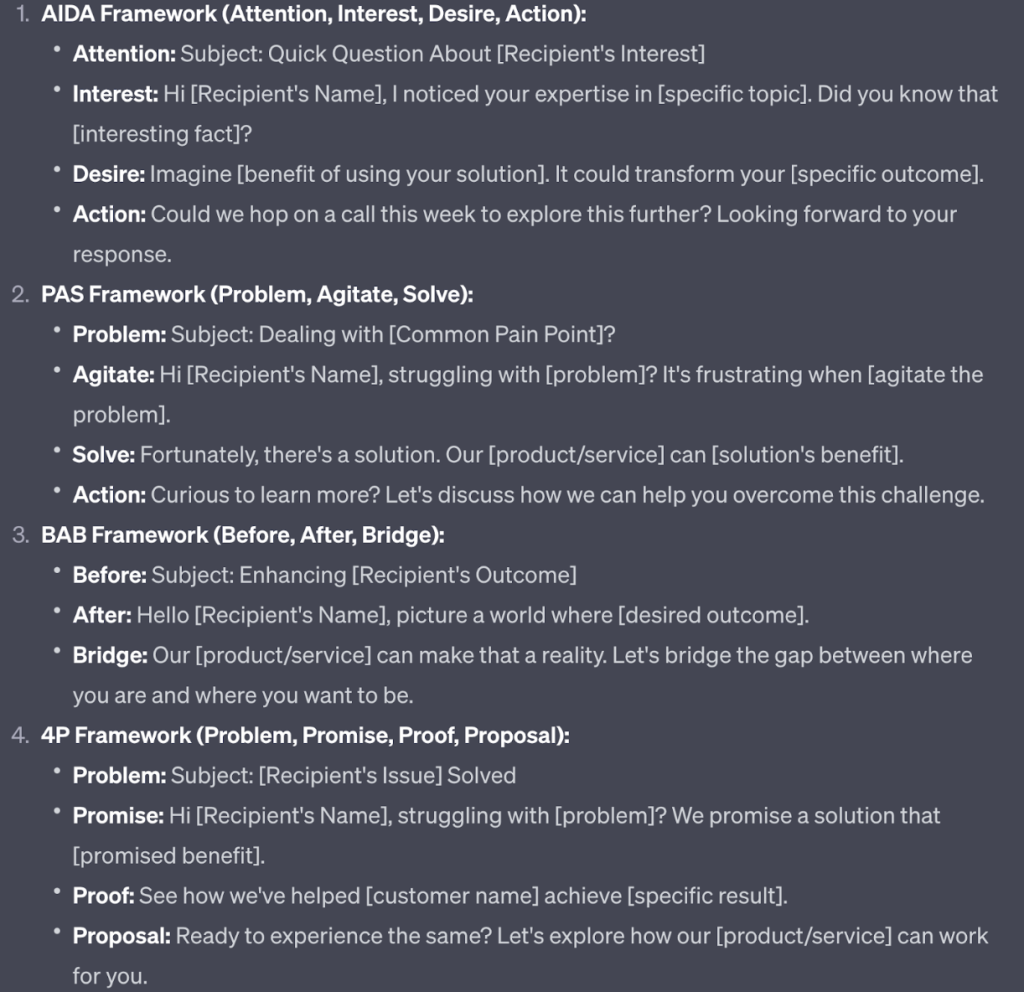
As you can see, the structure of each of them is simply described like instructions. Just follow them and you will create an effective email based on a framework that has proven to be effective. Why reinvent the wheel when you can use what you know already works?
I’ll post the remainder of the list here for anyone new to these frameworks. Note how easy they are to create but, at the same time, they’re effective because they tell a story and get your point across in a clear and simple way.
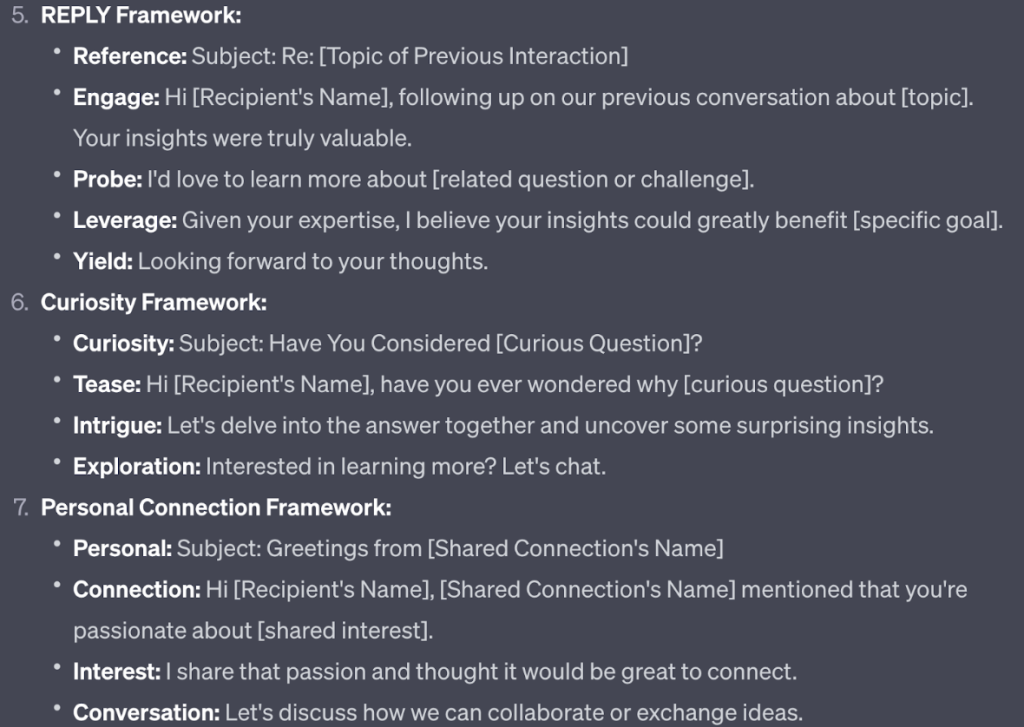
And the final three. Again, notice how there is a deliberate plan at work in each of the frameworks. You can see why they are used over and over in cold outreach — because they engage recipients.
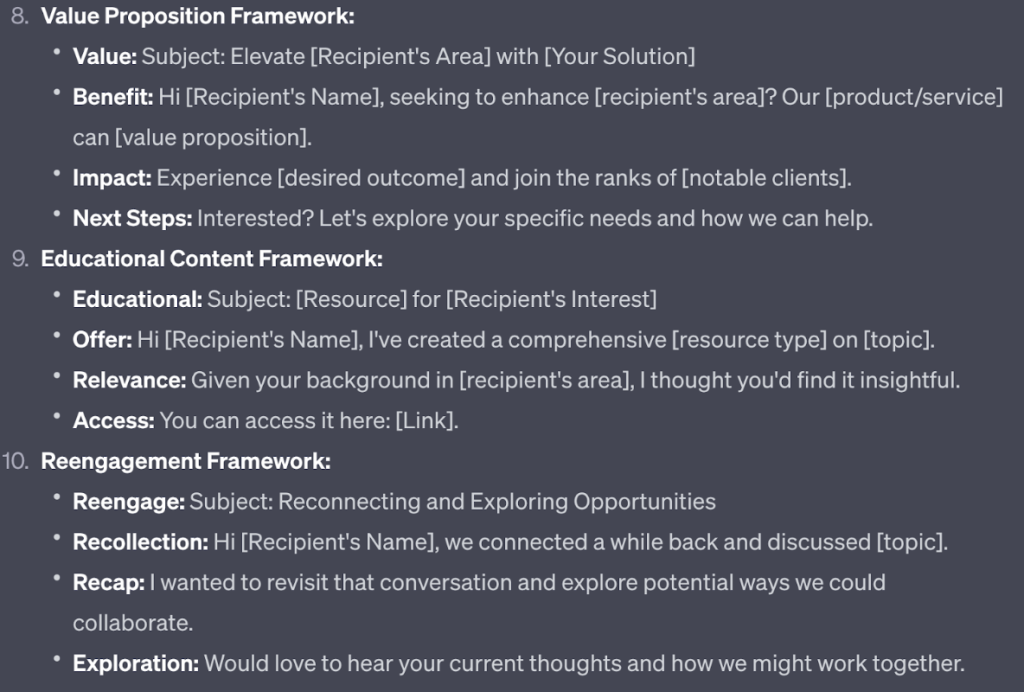
Ok, so we have established that AI tools are perfectly aware of:
- the existence of cold email frameworks
- how those frameworks break down into individual components
- how they fit together to create a compelling message
Now, here’s where it gets really interesting with the addition of AI.
On one hand, we have the power of AI tools, which, as we already know, can come up with more ideas than you can, more quickly. On the other hand, we have cold email frameworks that have proven to be effective and provide a perfect guide that only needs details from you.
Can we combine them to get the best of both worlds?
Yes we can! Instead of asking your AI text generator to start from zero when crafting your cold emails, let it start with a well-known cold email framework.
Note: The input you give AI tools to tell them what kind of content you need is called your “prompt”. You put your prompt in the empty field where you type things like “Write an email offering an online management course for IT professionals”, etc. Prompts are a very important part of using AI to create texts of every kind but they will be the focus of the next part in this series.
So instead of asking for a generic, general message about, say, promoting a management training course without giving any instructions regarding the structure, we can get something that follows a framework built on experience and aimed at triggering an emotional response to the offer.
Let’s start with that generic email with no framework. This will be our baseline. Here are the results I got from “Write a cold email promoting a management course for IT professionals”:
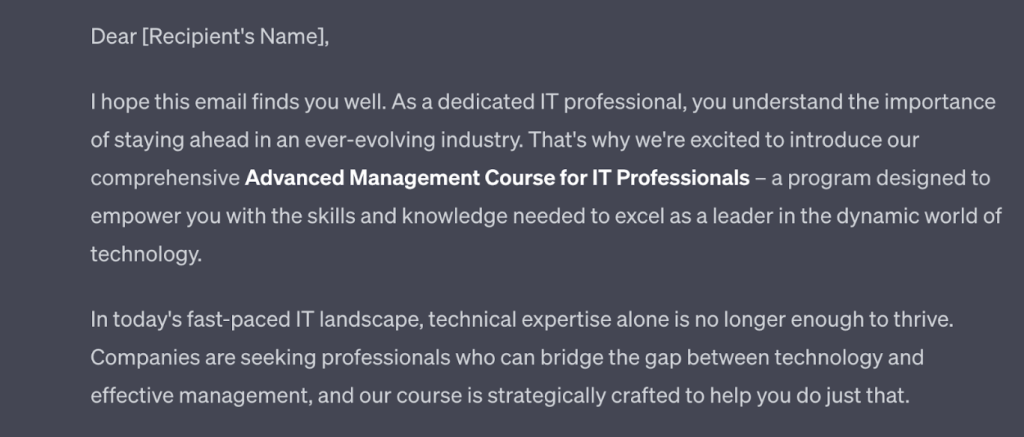
Not a bad introduction, even if AI tools seem to use the “I hope this email finds you well” intro way too often. For me, it’s a dead giveaway that the text was composed by AI. Same with “fast-paced” — AI loves to describe everything like this. Still, it’s a perfectly fine start. It continues like this:
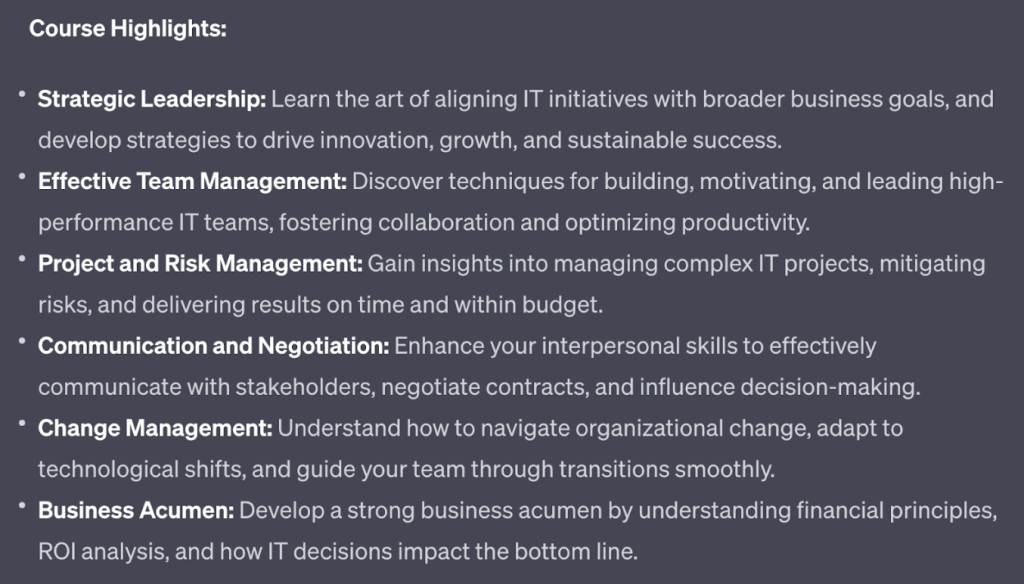
This is interesting because I didn’t give any details about the course in my prompt. You can either look at this as impressive because AI made up the course for me or as a problem because this may or may not match the actual content of the course. The lesson here is that AI will sometimes fill the holes in your prompt (yay, AI!) but that filler may or may not be accurate (what are you doing, AI?).
Here’s the last part of the cold email:

There’s more information about my course that I didn’t provide. Again, you can decide for yourself if that’s a plus or minus. There’s a standard cliche CTA about not “missing out”.
This email is probably a bit too long as well. Ideally, you want around 150 words, max. The length of this email is ok for a conversation that has already started but too much for a first contact.
When it comes to the overall tone and content, it’s a bit boring and safe. Good but not great. Enough but nothing extra. You get the idea.
Now let’s give the same basic input but add something extra at the end. This time, the prompt is “Write a cold email promoting a management course for IT professionals using the PAS framework”. So it’s the same as before, just with “…using the PAS framework” at the end. Here’s what I got:
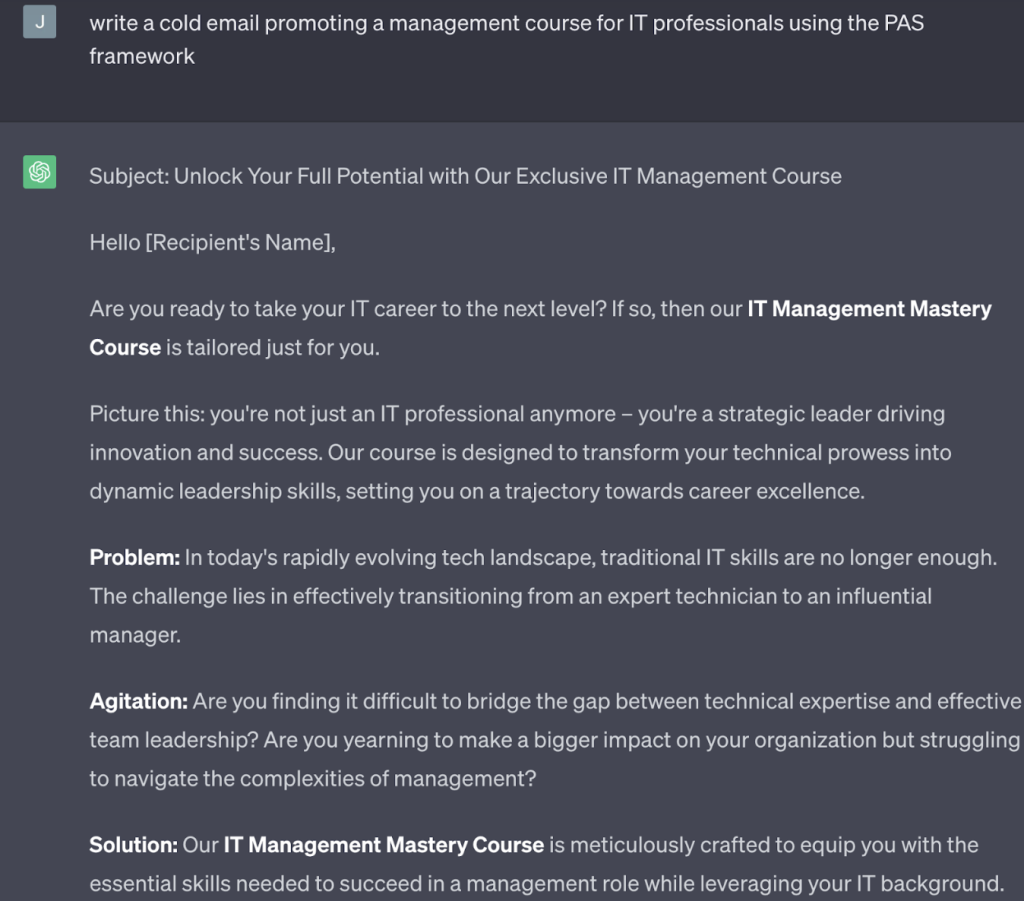
You can tell the difference right away. No more “I hope this email finds you well”. Instead, it starts immediately with a question that goes right to the central point of the email, “Are you ready to take your IT career to the next level?” There’s a personal, emotional element that’s present right from the start that was completely missing from the previous version.
The “Picture this” scenario is also a nice touch, a more human approach than the previous one. It puts the focus on what the recipient has to gain by reading on.
I do find it a bit odd that the AI actually included the words “Problem”, “Agitation” and “Solution” (the components of the PAS framework) in the text. I’m not sure why it’s there but it can be deleted easily enough. Also, the subject line that AI created isn’t right for a first cold email so it needs to be changed to something less salesy.
Anyway, you can clearly see that the framework, working together with the AI, produces a more emotionally-based message that shares a vision of a future that the recipient can achieve if they are interested in my management course.
Here’s the last part:
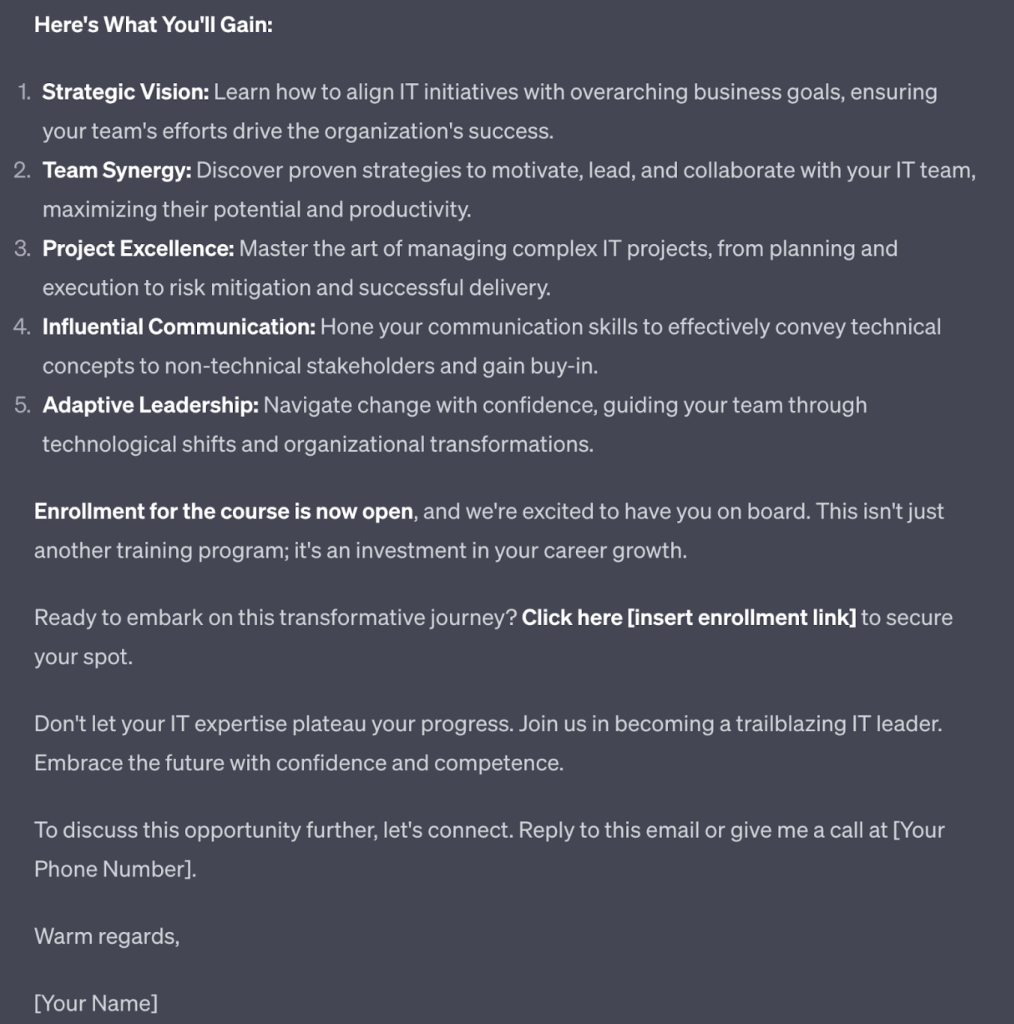
Like the previous version without “use the PAS framework” in the prompt, the AI has outlined the content of the course even though I didn’t provide it. It’s a bit shorter but much of the language is the same.
After the course description, the closing is warmer and more inviting than the other version. It’s about what the recipient has to gain rather than a boring “enrollment is open now”.
Altogether, I think it’s obvious that the second version, built on the PAS model, is superior to the other version in every way. It’s more human, more genuine, more persuasive and overall more effective. It definitely engages with readers more.
Whereas the first version feels like “We have a management course if you’re interested (yawn)”, the PAS version feels like there’s some excitement involved and it’s something that can really change things for you.
It’s a clear win for PAS.
Also, because I criticized the first, no-framework cold email for being too long, I asked AI to make a shorter version of the PAS framework email. When I used the prompt “Write a cold email promoting a management course for IT professionals using the PAS framework, make it 100 words or less”, here’s what I got:
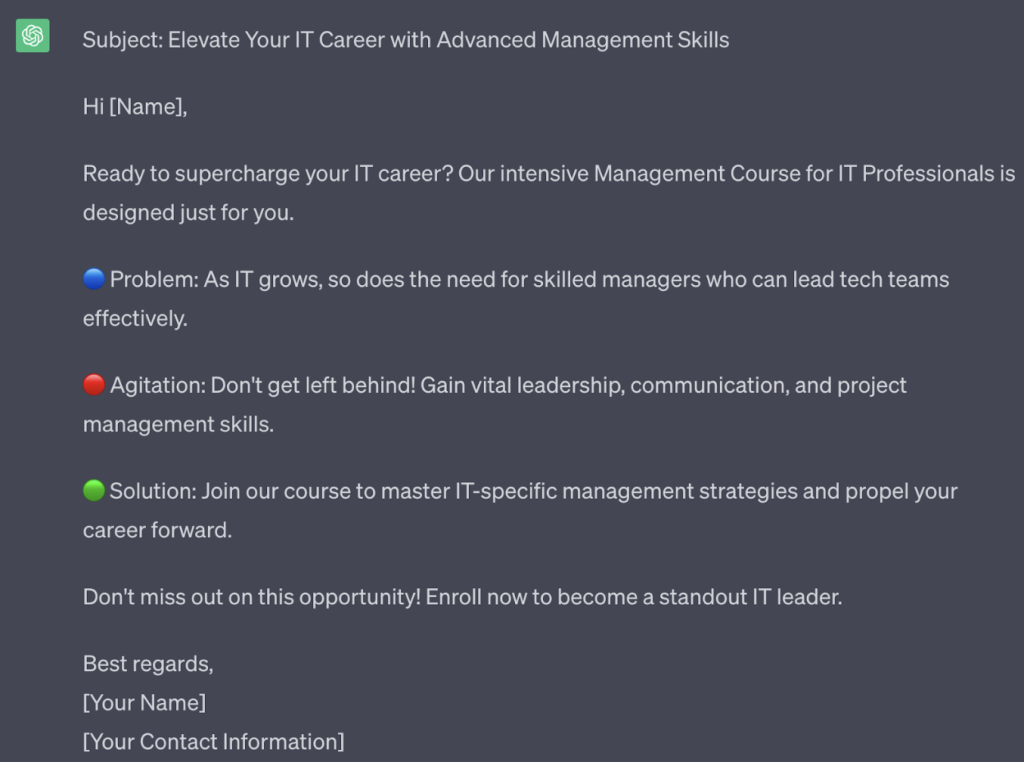
I got exactly what I asked for. This is a short, to-the-point version of the earlier PAS framework email, with just the highlights and no details about the course. The “Problem, Agitation, Solution” part is there again, this time in color (?). Time for the ‘Delete’ button again.
Not sure if the short & sweet version is more effective than the longer version with more details? With AI, you can easily create different versions of the same message for the purposes of A/B testing to find what works best with your audience.
Let’s try another one. I picked the “4P” framework this time. Why? No reason, I just like the name. Here’s what I got for “Write a cold email promoting a management course for IT professionals using the 4P framework”:
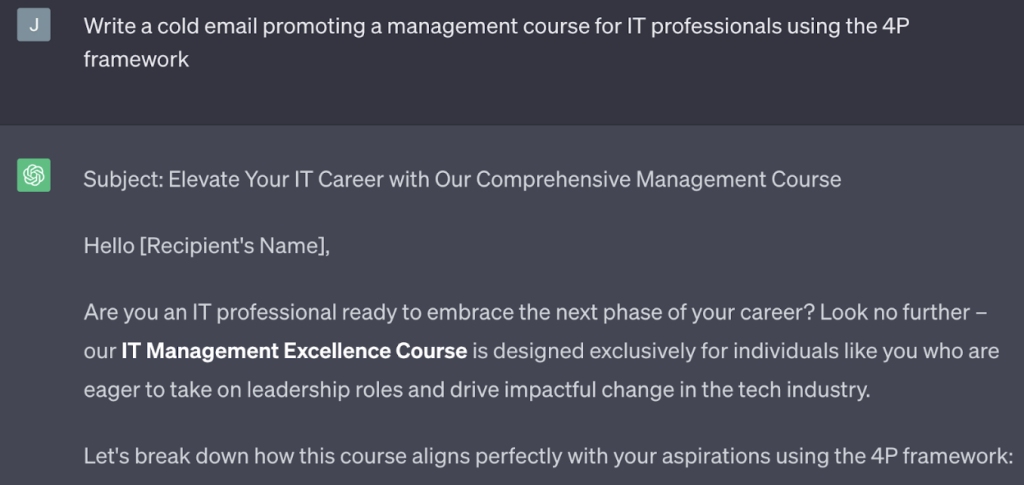
I was pleased to see that “I hope this email finds you well” is missing again. Like the PAS version, I like that the 4P version starts with a question about the recipient’s professional progress. The offer comes in the second sentence so the point of the email is already clear for the recipient.
I’m a little confused by the “Let’s break down how this course aligns perfectly with your aspirations using the 4P framework” part, though. The framework is supposed to be subtle, baked into the structure of the email without standing out. Using this sentence is like admitting that there is a structure at work here and we don’t want that.
And again, the subject line doesn’t really match the idea of what we’re trying to do with a cold email and needs something a little more subtle.
Minus one for AI. Here’s the next part:
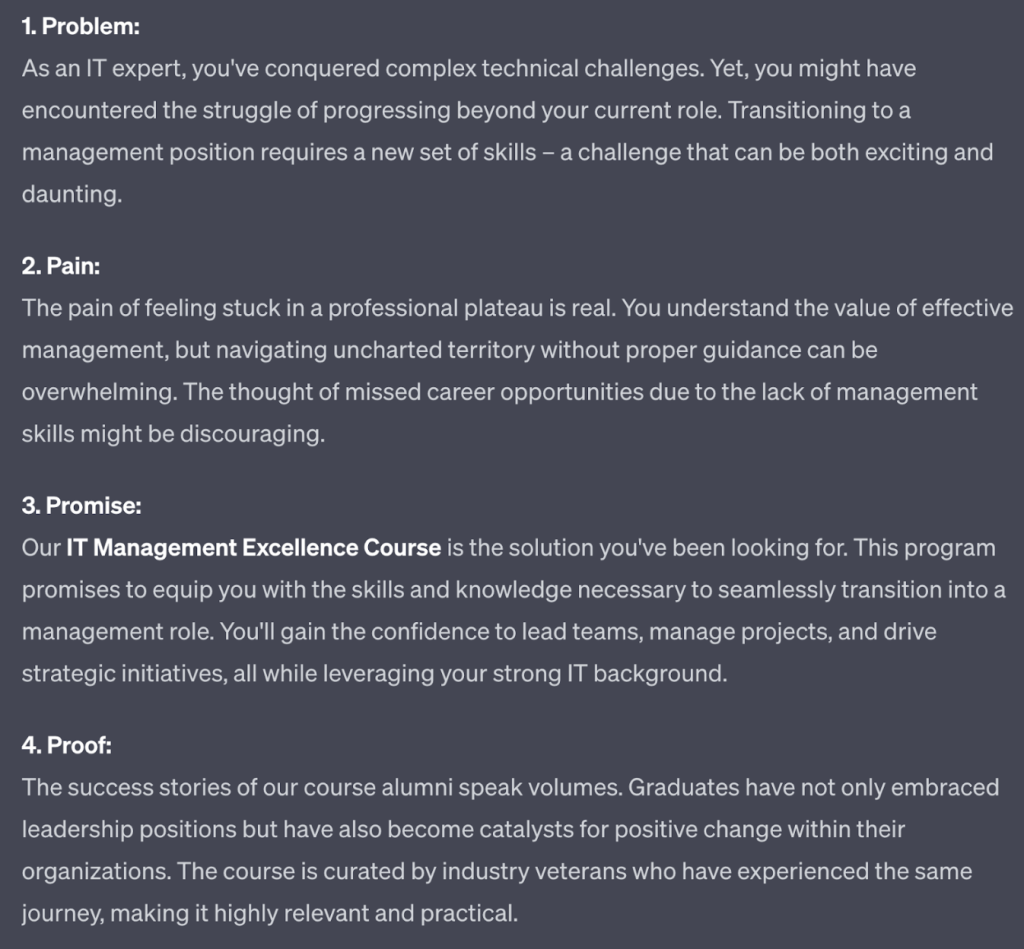
Again, it’s weird that the AI actually labels each part of the framework, like it did in the PAS model before. These “4Ps” can and should be deleted. Still, the content here is solid, starting with the problem (acquiring new skills to advance professionally) and moving through the rest of the story to success at the end.
There’s a narrative here and it’s easy for recipients to imagine themselves as the star of the story. That’s the whole point.
Here’s the ending:
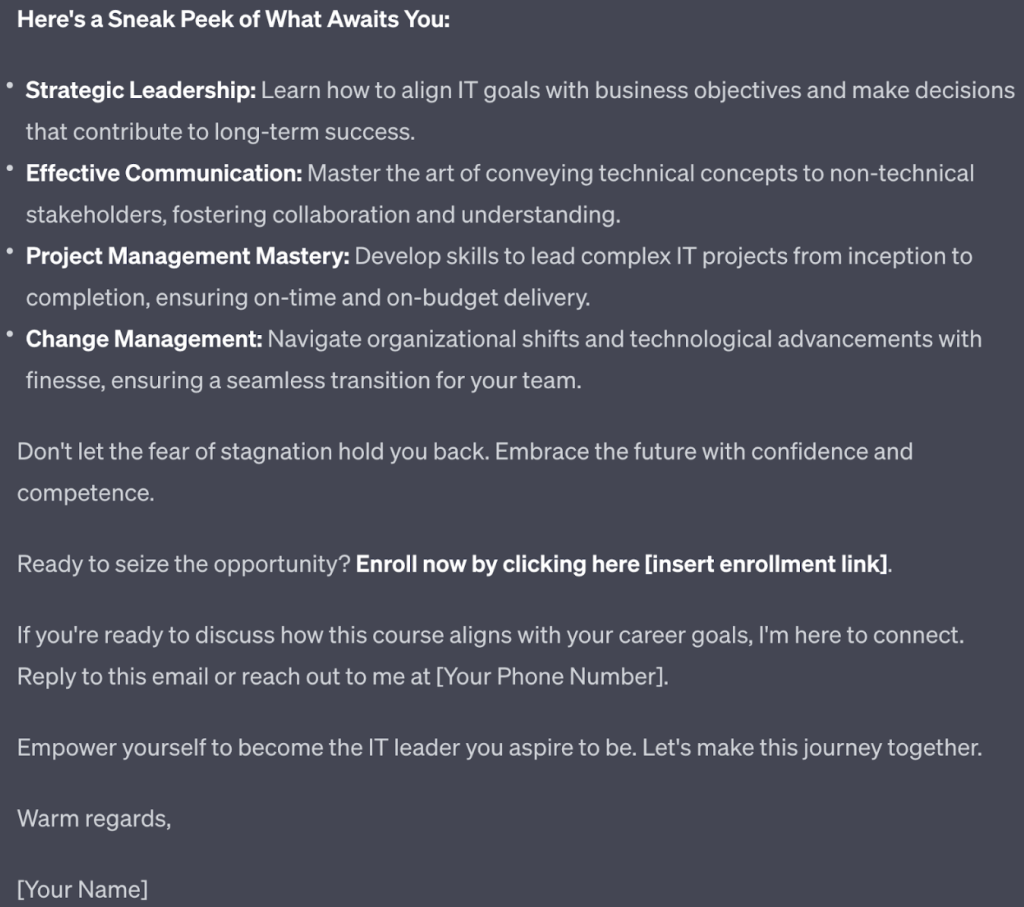
Again, AI filled in the details of my course (using basically the same content as before). It looks like AI just can’t stand to mention a course without providing the details.
The closing to this 4P model, like the PAS model before it, is again full of action language and generally better suited to this kind of email. In fact, it’s so full that it seems that AI decided to add four CTAs at the end there, which is obviously too much.
This might not be the perfect representation of a framework created by email pro Josh Braun, but it’s a good starting point to edit it down. Still, overall it’s another clear win for cold email frameworks.
You could repeat this with every cold email framework listed above and I’m sure you would get similar results. These frameworks have been around long enough to get their own names because they work. They’re based on strategies, feedback and testing that all confirm what we can see here in these screenshots — they are effective ways to communicate your ideas quickly and in an engaging way.
Let’s run one last little experiment with AI, this time using the AIDA framework. Remember that you can see descriptions of this and other frameworks in the first screenshots above.
Here’s what I got when I entered “Write a cold email promoting a management course for IT professionals using the AIDA framework”:
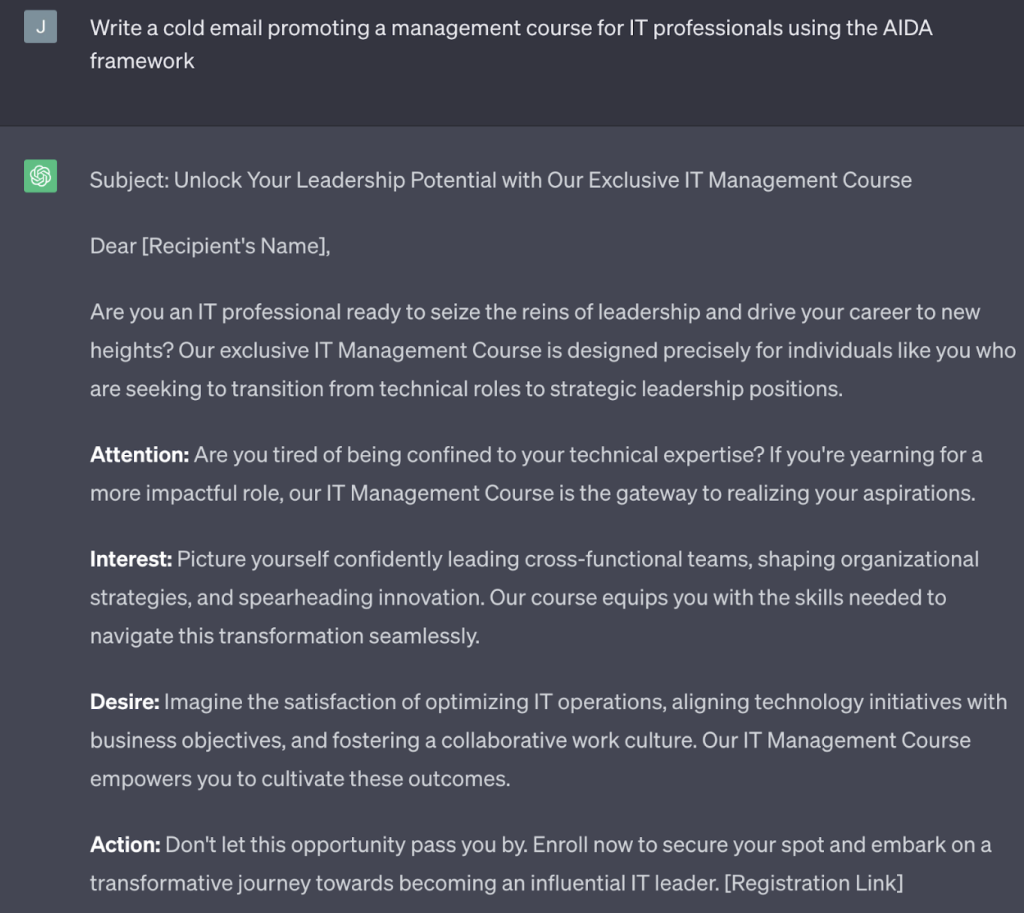
Another email that starts with a question — I like it. The entire intro, following the AIDA format, creates a relatable narrative about self-improvement and taking the path forward. It’s action-oriented and offers a clear way for the recipient to respond.
Unfortunately, once again we have the elements of the framework literally spelled out on the page. Not sure why it does that but, again, that’s what the “Delete” button is for.
Here’s the rest:

Once again there’s a description of the course that I didn’t provide but this time it’s shorter for some reason, making the entire email only about two-thirds the length of the PAS and 4P frameworks.
The closing is also shorter, although still with motivating language that creates urgency. Why did the PAS and 4P models have four or five sentences in the closing and this AIDA framework only has one? The answer is buried deep in an AI algorithm somewhere and I’m not going to look for it. Let’s use it as a good reminder that we’re still dealing with machines here and the answer to some of the things they do is “just because”.
Still, even though it isn’t as good as the PAS and 4P frameworks, this email built on the AIDA framework is still better than the original I got above that doesn’t use a framework at all. Go back and look at that first email again and imagine what your reaction would be if it landed in your inbox versus the reactions to the other three emails we looked at.
It’s not even close — a framework, any framework, wins every time.
Why cold email frameworks make your cold emails better
Cold email frameworks got better results than “regular” cold emails long before AI was part of the conversation for a few reasons:
- They provide a structure for your message
- That structure taps into different human emotions and aspirations
- The structure allows for a short story to be told
- In the absence of these elements, what remains is not compelling or interesting
Email frameworks have long been a go-to tool for marketers and now that the rush to take advantage of AI-generated content is on, smart marketers will bring the frameworks with them. After all, as we’ve seen, AI tools are perfectly capable of following the “map” that different frameworks create. A little guidance is all they need.
In the case of the emails above, I would use that guidance to bring the ‘salesy’ factor down by a point or two. AI sometimes seems to equate cold emails with sales emails and they’re not the same thing, especially at the start of the conversation.
And speaking of guidance, in our next post in this series about using AI to create better cold emails, we’ll look at the tool that provides the guidance that AI needs to create any text — prompts. Want to build on top of cold email frameworks and use AI to generate a whole new world of creative messaging? stay tuned for our future post on the power of the prompt.
READ ALSO

How AI Email Writing Assistants Can Help You Out with Cold Emails – Pt 1
With the recent debut of ChatGPT, it seems that all we hear about is how AI is taking over. Taking our jobs! Making people obsolete! Threatening our very existence! We’re all doomed!
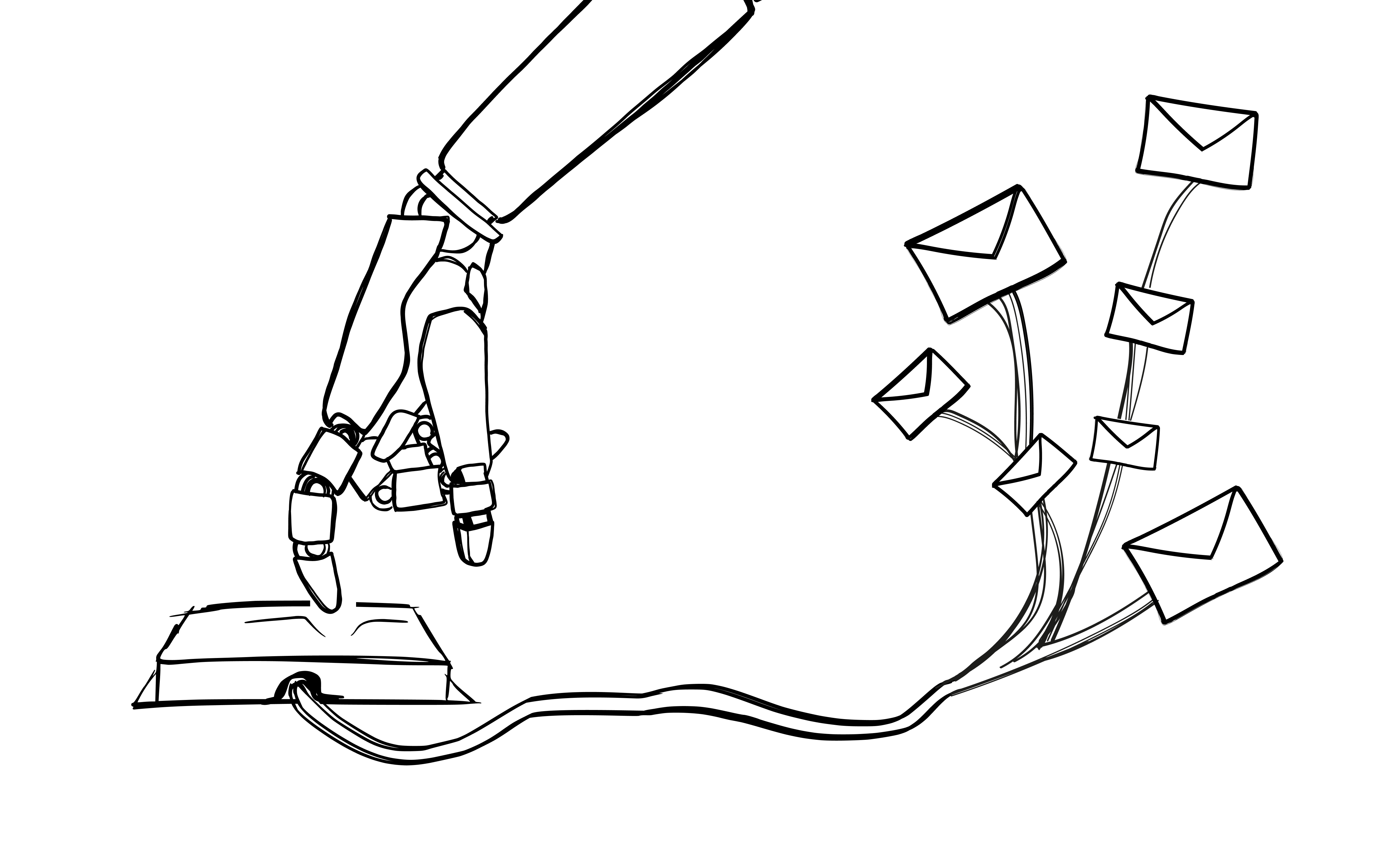
How AI Email Writing Assistants Can Help You Out with Cold Emails – Pt 2
This time, I’m going to get into some specifics by testing a selection of some of the more familiar names out there in the AI email tool space along with our own, new integration — an AI-assisted composition tool for Woodpecker.
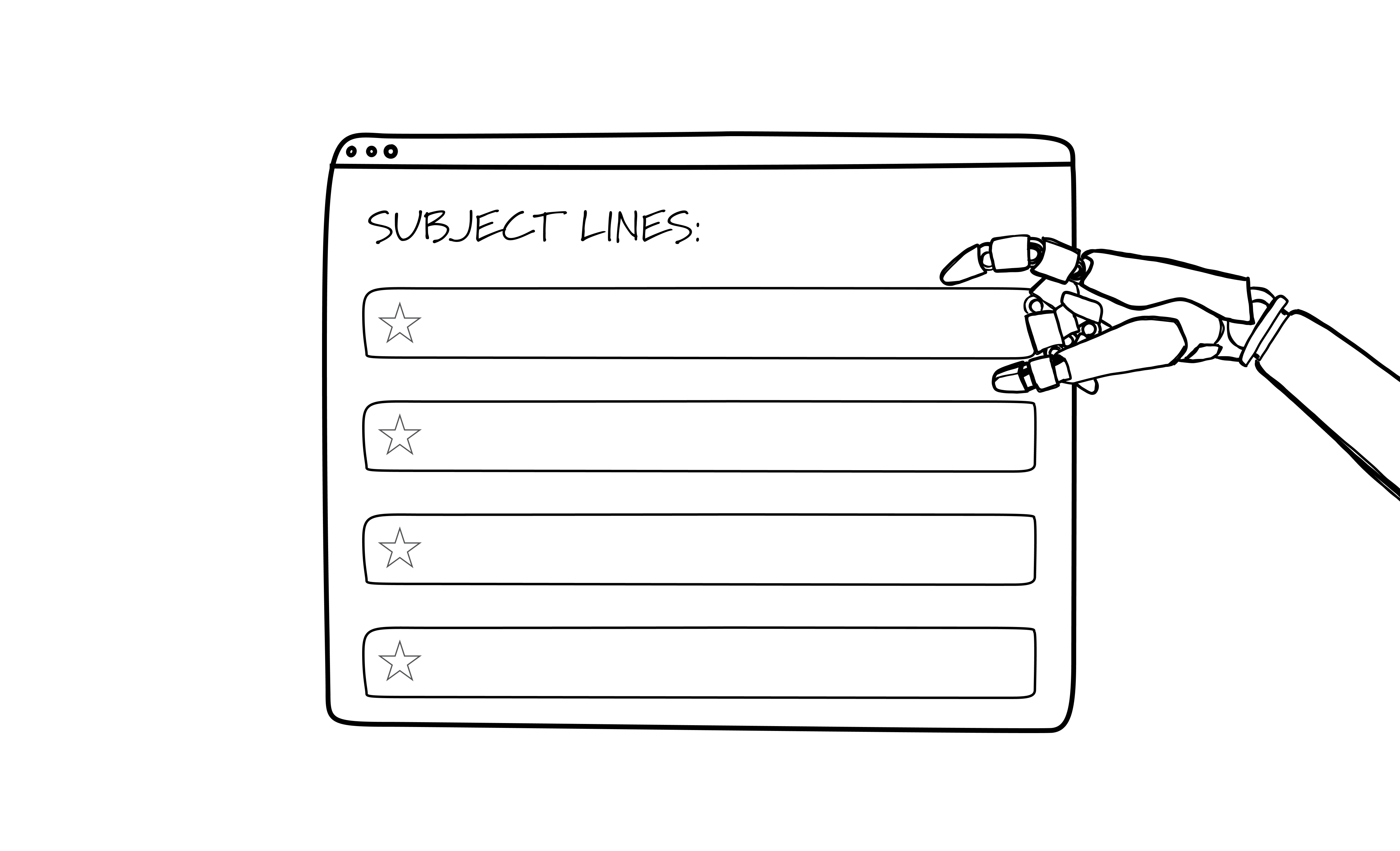
Testing AI Tools to Write Email Subject Lines
AI can help you write better subject lines, or can it? We looked at a few tools to see what they can produce and the results might surprise you.